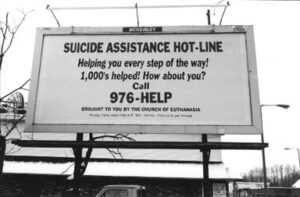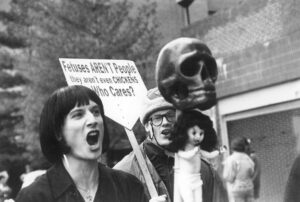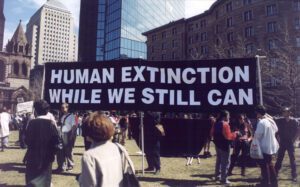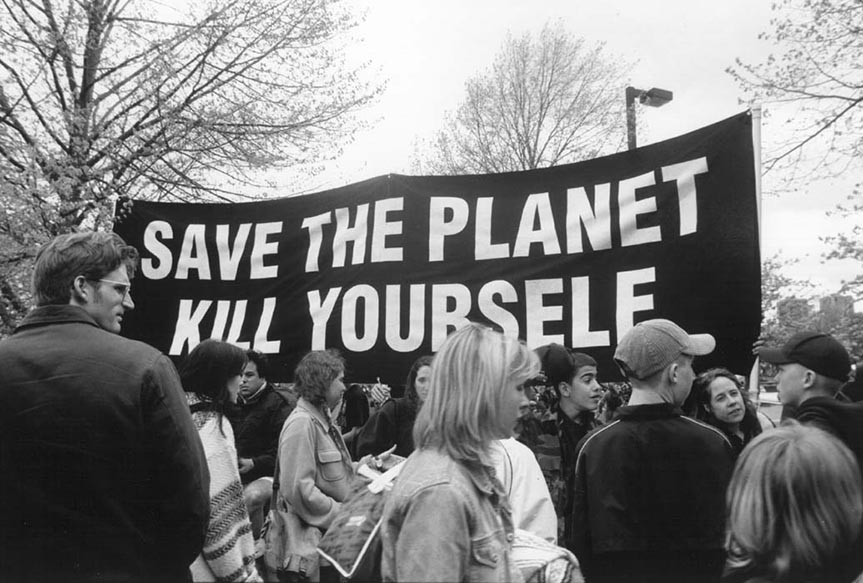If you thought that Extinction Rebellion was extreme, then you’ll love the Church of Euthanasia.
Before the novel coronavirus dominated the news scene so heavily, the environmental group Extinction Rebellion was capturing headlines with its passive protests. Although the group received widespread support for some of its activities, the public were a little more reluctant when protestors blocked bridges or highways. It seems our desire to save the planet is limited to activities that don’t actually involve too much inconvenience.
In 1992, in Boston, another group was formed that took a far more radical approach to changing the way we treat the environment. In fact, this group were so passionate in its beliefs that it declared itself a religion rather than a mere movement. The Church of Euthanasia was formed by Reverend Chris Korda and Pastor Kim under its most well-known slogan: “Save the planet, kill yourself.”
For some, it proved quite a catchy headline, and soon dozens of people were seeing the light and signing up. The fundamental core of the religions belief system is that of “restoring balance between humans and the remaining species on earth.” To do this the group believes that a massive drop in population is required.
Read more: Skull Charcoal: Too Macabre or Pure Genius?
While many may agree that human fingerprints are at the heart of nearly every environmental problem we are facing today, it was the religion’s methodology that caused the most raised eyebrows. Their one overriding command—”Though shalt not procreate”—was supported by four underlying principles:
- Suicide: “Optional but to be encouraged.”
- Abortion: “May be required to avoid procreation.”
- Cannibalism: “Mandatory if you insist on eating meat.”
- Sodomy: “Optional but strongly encouraged.”
With stated principles such as these, it was not long before the group was drawing a large amount of media attention—which it thrived on and believed was important to their cause.
The Reverend Chris Korda, who identifies as transgender, claimed she didn’t just make this belief system up. She was visited by an alien called “The Being” who instructed her to start taking these controversial actions because he was very concerned about the environmental degradation humans were causing.

In 1995, the group expanded its exposure by purchasing a billboard on the side of a highway which offered access to suicide advice. The sign included the message “Helping you every step of the way!” and a phone number you could call if you needed advice or just wanted to discuss your journey to the afterlife. In the same year, Korda also started a campaign called Unabomber for President.
Read more: Euthanasia Coaster: The Ultimate Roller Coaster Ride
By then the Church of Euthanasia’s antics had started to catch the eye of the more mainstream press, and in 1997, the group made it onto the widely viewed Jerry Springer Show. The show itself is famed for highlighting controversial issues and characters, but even for Springer this was a hard act to control. The Reverend Kim arrived bearing a crucifix with a chicken nailed to it. With one outrageous act or statement following another, the group soon had the studio audience in an uproar, and Springer was forced to clear the stage. For a group that thrived on being controversial, this was a big step and suddenly the Church of Euthanasia was catapulted into the limelight, though briefly.
This was a religion that courted notoriety and confrontation. Its followers performed acts that were designed to cause controversy, and they frequently clashed with pro-life campaigners. It was a conflict Church of Euthanasia members seemed to actively pursue. They may not have admitted to wanting to provoke these people, but arriving at a pro-life march bearing signs saying “Fetuses aren’t people / They aren’t even chickens / Who cares?” and “Human extinction while we still can” were reasonably sure to generate a certain level of animosity.

In 2001, following the September 11 attacks, the group posted a video combining hard-core porn, footage of the falling World Trade Centre, and songs performed by Korda herself. One was entitled “I love to watch.” Suddenly, it wasn’t just the pro-lifers they had antagonized. A nation that was already in mourning following its biggest ever domestic terror attack was now enraged.
Unrepentant, in 2003, Korda went on to post instructions on “how to kill yourself” on the Church of Euthanasia website. The method the group prefers is asphyxiation through the inhalation of helium. The technique seems to be effective as a 52-year-old woman died using it in St. Louis County, Missouri. This incident could have led to a rather vicious court case and the site was quickly taken down.
Read more: Walking Corpse Syndrome: Walking Dead Comes to Life

The religious organization has since ceased to operate, or at least it appears to have done so. Looking back at the aftermath, people have differing views on how the Church of Euthanasia should be remembered. Some see what the group was doing as performance art; others as a desperate cry for any form of attention; and a few as a group that was using extreme measures to draw public attention to what is an extreme problem—a case of even the worst forms of publicity being better than allowing humankind’s destruction of the planet to linger on the back burner. Korda herself makes no apologies.
Korda was heavily influenced by the Dada movement that started as a response to the horrors of World War I. Dadaism attracted a broad spectrum of poets, artists, and writers who rejected reason and logic in favor of more extreme forms of expression. A few people outside of the organization argue that the group was not extreme. Whether the group was a cult or just a bunch of people wanting a moment in the spotlight is up for debate. What is beyond doubt is that for a brief moment in time, they attracted plenty of attention.


